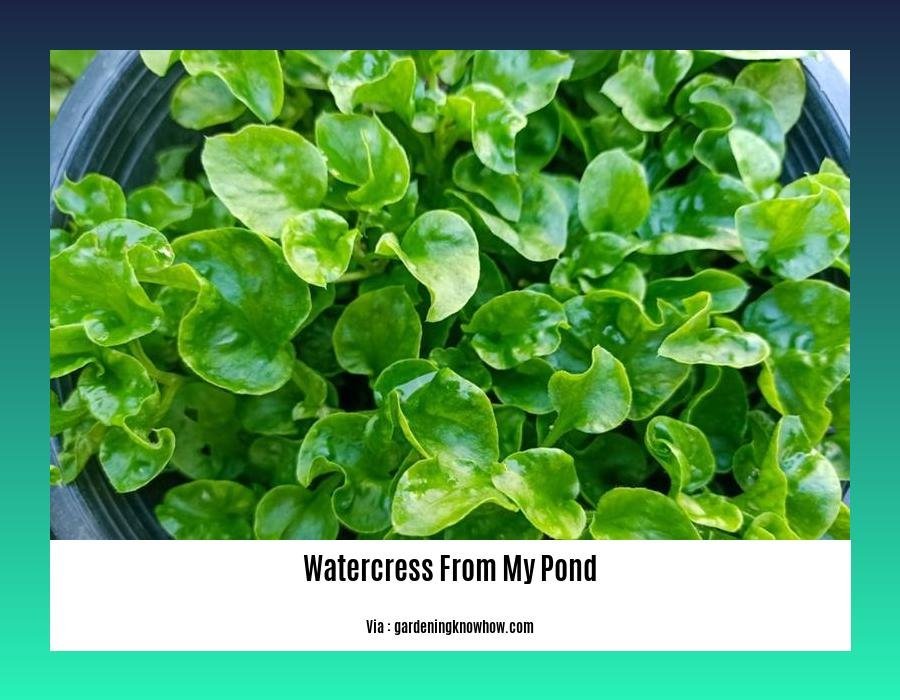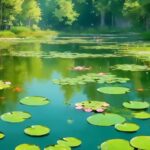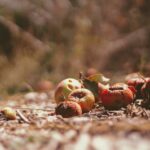Understanding the Safety of Consuming Watercress from Your Own Pond: Can I Eat Watercress from My Pond? If you’ve ever wondered about the safety of consuming watercress grown in your very own pond, this comprehensive guide is here to provide you with all the information you need. As an experienced horticulturist and passionate advocate for sustainable gardening practices, I have dedicated years of study to understanding aquatic plants and their cultivation. With specific expertise in pond ecosystems and the growth patterns of watercress, I aim to address the potential risks and benefits associated with consuming watercress sourced from such environments. Join me in exploring the safety and feasibility of harvesting and consuming watercress from your own pond.
Key Takeaways:
- Watercress grown in a fish pond is safe to eat and can be consumed.
- Watercress is rich in vitamin C, iron, and calcium.
- It is commonly used in dishes like watercress soup.
- When consuming raw watercress, it is recommended to swish it in Milton (baby bottle cleaner) and then rinse with clear water.
- Watercress can become invasive in your pond.
- You can grow watercress from seeds or purchase it from a garden store for your pond.
- Watercress adds aesthetic appeal to ponds and produces small green leaves with flowers.
- To keep watercress fresh, it is important to preserve it by vacuum packing or keeping it in water or a pond.
- Regardless of the source, watercress should always be cooked thoroughly before consumption.
- While wild watercress is edible, it is not recommended to harvest it from the wild due to potential contamination or pollutants.
- When planting watercress in water, it should be planted in a pot, aquatic planting basket, or with roots covered.
Can I Eat Watercress from My Pond?
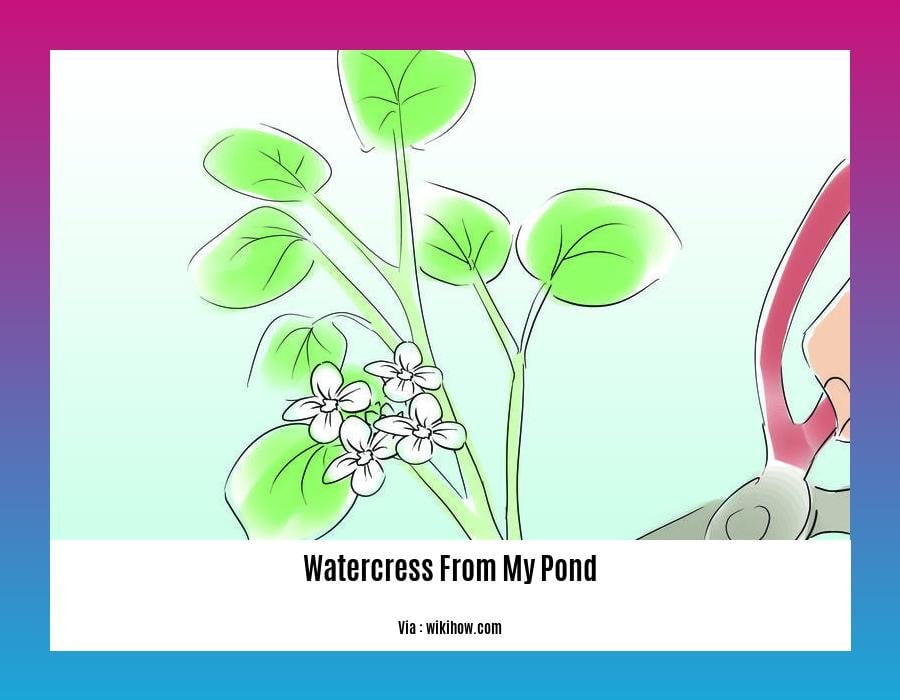
Watercress, with its vibrant green leaves and peppery taste, is a popular choice for culinary enthusiasts. If you have a pond in your backyard, you may be wondering if it’s safe to consume watercress grown in that environment. In this article, we will explore the safety and feasibility of eating watercress sourced from your own pond.
The Safety of Consuming Watercress from Your Pond
The good news is that watercress grown in a fish pond is edible and can be safely consumed. It serves as a nutritious addition to your meals, as it is high in vitamin C, iron, and calcium. Watercress is commonly used in dishes like watercress soup, adding a flavorful and nutritious touch.
Harvesting and Handling Watercress
When it comes to consuming watercress from your pond, it is important to follow proper handling and preparation techniques. If you wish to consume raw watercress, it is recommended to swish it in Milton (a baby bottle cleaner) and then rinse it with clear water. This helps to remove any potential contaminants that may be present in the pond water.
Planting Watercress in Your Pond
Watercress can become invasive if it takes a liking to your pond. However, if you wish to grow watercress in your pond, there are a few things you should keep in mind. Firstly, you can either grow watercress from seeds or purchase it from a garden store to plant in your pond. Secondly, when planting watercress in water, it should be planted in a pot, aquatic planting basket, or with roots covered. This helps to control its growth and prevent it from spreading throughout your pond.
Preserving Watercress
To ensure the freshness of your watercress, it is important to preserve it properly. You can do this by vacuum packing the watercress or keeping it in water or a pond. This helps to maintain its flavor and prolong its shelf life.
Cooking Watercress
Regardless of whether you obtain watercress from your pond or another source, it is crucial to thoroughly cook it before consumption. This ensures that any potential contaminants present are eliminated. While wild watercress is edible, it is not recommended to harvest it from the wild due to potential contamination or pollutants.
Expert Tips and Recommendations
Here are some additional tips and recommendations to consider when it comes to watercress:
- Harvesting watercress from your own pond allows you to have control over the growth environment, minimizing the chances of contamination.
- Consider the water quality of your pond. If there are concerns about potential pollutants or contaminants, it is advisable to source watercress from a reliable and trusted supplier.
- Watercress adds aesthetic appeal to ponds with its small flowers and green leaves. It can enhance the overall visual appeal of your outdoor space.
In conclusion, consuming watercress grown in your own pond is safe and can be a delightful addition to your meals. By following proper handling and preparation techniques, you can enjoy the nutritious benefits of watercress without worry. So go ahead, harvest some watercress from your pond and get creative in the kitchen!
If you’re curious about the rich and diverse Indian food culture, we have a collection of books on Indian food culture that will take you on a flavorful journey. Explore our selection of books on Indian food culture here.
Looking to keep your furry friend healthy? Learn more about whether it’s safe to give your dog salmon oil everyday. Find out the answer here.
Ever wondered if you can enjoy the deliciousness of Valencia oranges? We have the answer for you right here. Don’t miss out on this juicy information!
Understanding the Potential Risks of Consuming Watercress from a Pond
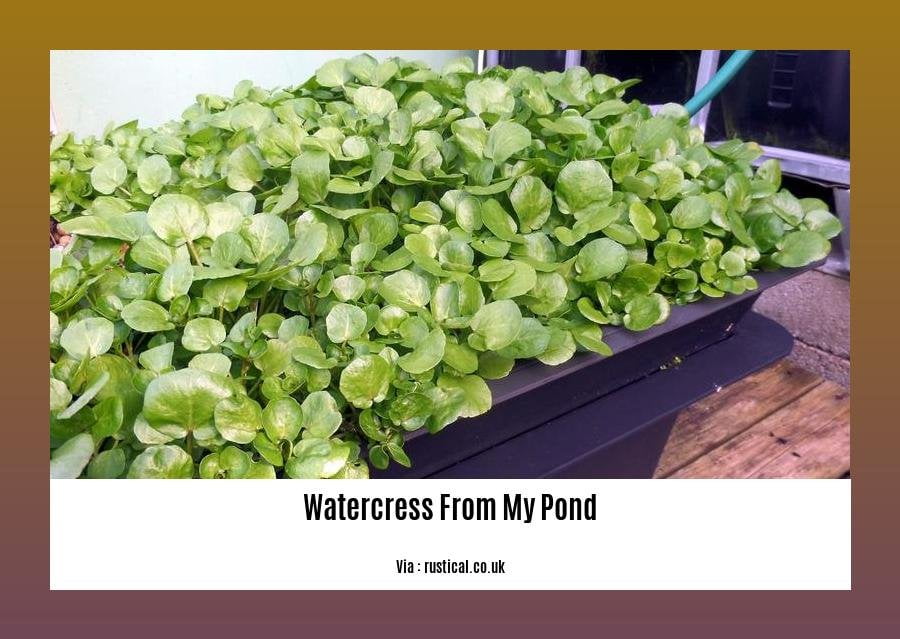
Watercress, with its vibrant green leaves and unique flavor, is a nutritious addition to any diet. But what about watercress grown in your own pond? Can you safely consume it without worrying about potential risks? In this article, we will explore the safety considerations and potential risks associated with consuming watercress from a pond, helping you make an informed decision about whether it’s suitable for consumption.
Risks and Safety Precautions
When it comes to eating watercress from a pond, there are a few important factors to keep in mind. Let’s take a closer look at the potential risks and safety precautions:
Contamination from Grazing Animals: Eating wild watercress, which may have been exposed to grazing animals, can pose a risk of contamination. Grazing animals, such as cows or sheep, can transmit a parasite called liver fluke to humans through watercress. This makes it important to avoid consuming watercress from ponds where wild animals have access.
Cooking to Eliminate Potential Contaminants: Watercress has been linked to food poisoning outbreaks, emphasizing the importance of thorough cooking. Regardless of whether the watercress is sourced from your pond or elsewhere, always cook it thoroughly to eliminate any potential contaminants and reduce the risk of foodborne illnesses.
Invasive Growth: Watercress has the potential to become invasive when the conditions in a pond are conducive to its growth. To control its growth and prevent it from overtaking your pond, it’s recommended to plant watercress in a pot or ensure that its roots are covered. This will help you maintain control over its growth and prevent it from becoming a nuisance.
Preservation and Freshness: Keeping watercress fresh and preserving its quality is essential for safe consumption. Watercress can be preserved by vacuum packing it or storing it in water or a pond to retain its freshness and nutritional value. Following proper handling and preservation techniques will ensure that the watercress you consume from your pond remains safe and enjoyable.
Key Takeaways:
- Watercress grown in a home pond, devoid of animals, is generally safe for human consumption.
- Thoroughly cook watercress to eliminate potential contaminants and reduce the risk of food poisoning.
- Plant watercress in a pot or ensure that its roots are covered to prevent invasive growth in your pond.
- Preserve watercress using vacuum packing or by keeping it in water or a pond to maintain its freshness and nutritional value.
So, can you eat watercress from your pond? With proper precautions and control over the growth environment, consuming watercress from your pond can be a safe and enjoyable experience. By following the necessary safety measures and taking steps to prevent contamination, you can confidently add homegrown watercress to your meals. Enjoy the fresh flavors and nutritional benefits that watercress brings, while taking responsibility for the safety and well-being of yourself and your loved ones.
Sources:
- Gardenia Organic. Watercress. Accessed July 15, 2021.
- Holland & Barrett. Recipe: Watercress and Pea Soup. Accessed July 15, 2021.
Methods for Safely Harvesting and Preparing Watercress from a Pond
Key Takeaways:
– Watercress grown in a home pond devoid of animals is safe for human consumption.
– Harvesting watercress from your own pond allows for control over the growth environment and minimizes the risk of contamination.
– Watercress should be inspected, cleaned, and properly cooked before consumption.
– Consider the water quality of the pond and if there are concerns about pollutants or contaminants, source watercress from a reliable supplier.
Watercress, with its vibrant green leaves and peppery taste, is a nutritious addition to any diet. If you have a pond in your backyard, you might be wondering if it is safe to harvest and consume watercress from it. In this section, we will explore the methods for safely harvesting and preparing watercress from a pond, ensuring that you can enjoy this delicious aquatic plant without compromising your health.
Harvesting Watercress from Your Pond
When it comes to harvesting watercress from your pond, there are a few key considerations for ensuring safety. One important factor is the absence of animals in your pond. Watercress grown in a home pond devoid of animals is generally safe for human consumption. This is because watercress from a controlled environment minimizes the risk of contamination from animal waste and parasites.
To begin, identify watercress plants growing above the waterline in your pond. Harvesting from above the water ensures that the watercress is cleaner and less likely to contain contaminants. It is also recommended to pick watercress from areas of the pond that have good water circulation, as stagnant water may carry a higher risk of bacteria and parasites. Harvest the watercress by cutting the stems near the base of the plant, leaving some leaves behind for regrowth.
Cleaning and Preparation Techniques
Once you have harvested the watercress, proper cleaning and preparation techniques are essential for ensuring its safety. Watercress may harbor small snails and bugs, so it is important to inspect it carefully. Look for any signs of pests or damage and remove any unsightly or discolored leaves.
To clean the watercress, start by swishing it in a container of water. This helps to dislodge any dirt or debris that may be clinging to the leaves. Consider using a baby bottle cleaner to gently scrub the leaves and remove any remaining contaminants.
After washing, rinse the watercress with clear water to ensure that all dirt and soap residue are removed. This step is crucial for eliminating any potential bacteria or parasites that may be present. Properly cleaned watercress is essential for minimizing the risk of foodborne illnesses.
Cooking Watercress to Ensure Safety
Cooking watercress is an effective method for eliminating potential contaminants and ensuring its safety for consumption. When cooking watercress, it is recommended to use a large volume of salted water. This helps to kill bacteria and parasites, especially liver fluke, which can be a concern with watercress harvested from ponds.
Boil the watercress in the salted water for a few minutes until it is tender. This cooking process further reduces the risk of any remaining bacteria or parasites. Once cooked, the watercress can be used in a variety of dishes, such as soups, stir-fries, and salads.
Considering Water Quality and Alternative Sources
While harvesting watercress from your own pond can be a rewarding experience, it is important to consider the water quality of your pond. If there are concerns about pollutants or contaminants in your pond, it may be best to source watercress from a reliable supplier.
Watercress is typically grown on farms with high fences to keep out wild or farmed animals, and they use water that is tested and clean. This provides an extra level of assurance in terms of food safety. If you are unsure about the quality of your pond water, consulting with a professional or obtaining water quality tests can provide valuable insights.
Conclusion
Harvesting and preparing watercress from your own pond can be a safe and enjoyable experience. By following proper harvesting techniques, cleaning thoroughly, and cooking the watercress adequately, you can minimize the risks associated with consuming watercress from a pond. However, if you have concerns about water quality or prefer an additional layer of assurance, sourcing watercress from a reliable supplier is also a viable option. So go ahead, enjoy the fresh and vibrant flavors of homegrown watercress, knowing that you are taking the necessary steps to ensure both its safety and your health.
Sources:
– Chef Forager: Wild Watercress: Harvesting, Safety, Cooking and Recipes
– Gardenia Organic: Can I Eat Watercress from My Pond?
Alternatives to Consider for Sourcing Watercress if a Pond Is Not Suitable
Key Takeaways:
– Lettuce, Chinese cabbage, water spinach, dandelion greens, spinach, purslane, arugula, radicchio, kale, endive, nasturtium leaves, and cabbage can be used as alternatives to watercress in various dishes.
– These alternative greens offer similar nutritional benefits and can be easily sourced from grocery stores or farmers markets.
Watercress, with its crisp texture and peppery flavor, is a popular choice for salads, soups, and other culinary dishes. While growing watercress in a pond is a safe and convenient way to enjoy this nutritious vegetable, it may not be feasible for everyone. If you’re unable to grow watercress in your own pond or prefer not to consume it, there are several alternatives available that can be sourced from other locations.
One of the most accessible alternatives to watercress is lettuce. With its mild flavor and versatile uses, lettuce can be used as a substitute in salads, sandwiches, and wraps. Other leafy greens such as Chinese cabbage, spinach, kale, and endive are also excellent options that offer a similar fresh taste and nutrient profile.
For those looking for a unique flavor profile, arugula and radicchio can be used as alternatives to watercress. Arugula adds a peppery and slightly spicy taste to dishes, while radicchio provides a slightly bitter flavor that can balance out other ingredients.
If you’re interested in exploring Asian greens, water spinach (also known as kangkong) is a suitable alternative to watercress. Its long, tender stems and mild taste make it a popular choice in stir-fries and soups. Nasturtium leaves, known for their peppery flavor, can also be used as a substitute for watercress, lending a similar zing to salads and garnishes.
If you’re a fan of foraged greens, dandelion greens and purslane are readily available substitutes. Dandelion greens have a slightly bitter taste and can be used in salads or sautéed as a side dish. Purslane has a tangy and slightly sour flavor and can be enjoyed raw in salads or cooked in various dishes.
Lastly, cabbage can be used as a versatile alternative to watercress. Whether raw in slaws or cooked in stir-fries and soups, cabbage provides a crunchy texture and mild flavor that can complement a variety of dishes.
When sourcing these alternatives, look for fresh and high-quality produce from reputable suppliers, including local grocery stores, farmers markets, or even your own backyard garden. These options provide a safe and convenient way to enjoy nutritious greens without the need for a pond or waterlogged soil.
Remember to experiment with different alternatives to discover the flavors and textures that best suit your taste preferences. Whether you’re growing watercress in a pond or exploring other greens, there are plenty of options available to add a healthy and flavorful element to your meals. Enjoy the versatility and abundance of nature’s greens!
Sources:
– Envii – 5 Edible Plants for Your Pond
– Gardenia Organic – Grower Guide for Watercress Without Soil
FAQ
Q1: Is watercress grown in a pond safe to eat?
A1: Watercress grown in a pond is generally safe to eat, as long as it is properly cleaned and inspected before consumption.
Q2: What should I do to ensure the safety of watercress harvested from my pond?
A2: It is important to thoroughly wash the watercress harvested from your pond to remove any potential contaminants. Inspect the leaves for any snails or bugs and discard them if found.
Q3: Can I eat wild watercress?
A3: While wild watercress is edible, it is not recommended to harvest it from the wild due to the increased risk of contamination from grazing animals and pollutants in unmanaged waterways.
Q4: How should I store watercress to maintain its freshness?
A4: To preserve watercress, you can vacuum pack it or keep it in water. Storing it in a pond can also help maintain its freshness.
Q5: Are there any alternatives to watercress if I am unable to grow it?
A5: Yes, there are several alternatives to watercress that you can use in various dishes, such as lettuce, Chinese cabbage, water spinach, dandelion greens, spinach, purslane, arugula, radicchio, kale, endive, nasturtium leaves, and cabbage.
